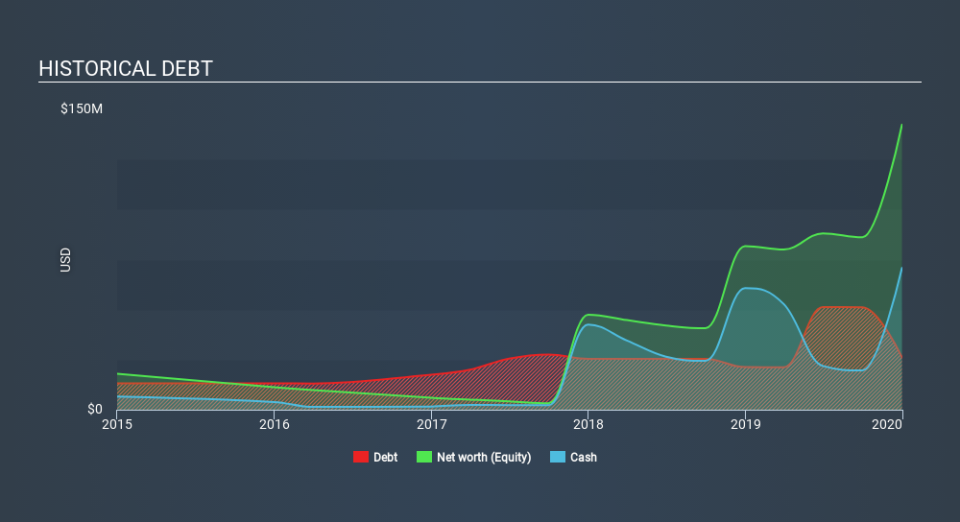Is OrthoPediatrics (NASDAQ:KIDS) Weighed On By Its Debt Load?

Some say volatility, rather than debt, is the best way to think about risk as an investor, but Warren Buffett famously said that 'Volatility is far from synonymous with risk'. It's only natural to consider a company's balance sheet when you examine how risky it is, since debt is often involved when a business collapses. As with many other companies OrthoPediatrics Corp. (NASDAQ:KIDS) makes use of debt. But is this debt a concern to shareholders?
When Is Debt Dangerous?
Debt and other liabilities become risky for a business when it cannot easily fulfill those obligations, either with free cash flow or by raising capital at an attractive price. In the worst case scenario, a company can go bankrupt if it cannot pay its creditors. However, a more usual (but still expensive) situation is where a company must dilute shareholders at a cheap share price simply to get debt under control. Of course, debt can be an important tool in businesses, particularly capital heavy businesses. When we examine debt levels, we first consider both cash and debt levels, together.
Check out our latest analysis for OrthoPediatrics
How Much Debt Does OrthoPediatrics Carry?
The image below, which you can click on for greater detail, shows that at December 2019 OrthoPediatrics had debt of US$26.2m, up from US$21.3m in one year. However, it does have US$70.8m in cash offsetting this, leading to net cash of US$44.6m.
How Strong Is OrthoPediatrics's Balance Sheet?
Zooming in on the latest balance sheet data, we can see that OrthoPediatrics had liabilities of US$13.7m due within 12 months and liabilities of US$38.5m due beyond that. On the other hand, it had cash of US$70.8m and US$16.6m worth of receivables due within a year. So it actually has US$35.1m more liquid assets than total liabilities.
This short term liquidity is a sign that OrthoPediatrics could probably pay off its debt with ease, as its balance sheet is far from stretched. Simply put, the fact that OrthoPediatrics has more cash than debt is arguably a good indication that it can manage its debt safely. The balance sheet is clearly the area to focus on when you are analysing debt. But ultimately the future profitability of the business will decide if OrthoPediatrics can strengthen its balance sheet over time. So if you're focused on the future you can check out this free report showing analyst profit forecasts.
Over 12 months, OrthoPediatrics reported revenue of US$73m, which is a gain of 26%, although it did not report any earnings before interest and tax. Shareholders probably have their fingers crossed that it can grow its way to profits.
So How Risky Is OrthoPediatrics?
We have no doubt that loss making companies are, in general, riskier than profitable ones. And the fact is that over the last twelve months OrthoPediatrics lost money at the earnings before interest and tax (EBIT) line. And over the same period it saw negative free cash outflow of US$30m and booked a US$13m accounting loss. However, it has net cash of US$44.6m, so it has a bit of time before it will need more capital. OrthoPediatrics's revenue growth shone bright over the last year, so it may well be in a position to turn a profit in due course. By investing before those profits, shareholders take on more risk in the hope of bigger rewards. When analysing debt levels, the balance sheet is the obvious place to start. But ultimately, every company can contain risks that exist outside of the balance sheet. Case in point: We've spotted 2 warning signs for OrthoPediatrics you should be aware of.
When all is said and done, sometimes its easier to focus on companies that don't even need debt. Readers can access a list of growth stocks with zero net debt 100% free, right now.
If you spot an error that warrants correction, please contact the editor at editorial-team@simplywallst.com. This article by Simply Wall St is general in nature. It does not constitute a recommendation to buy or sell any stock, and does not take account of your objectives, or your financial situation. Simply Wall St has no position in the stocks mentioned.
We aim to bring you long-term focused research analysis driven by fundamental data. Note that our analysis may not factor in the latest price-sensitive company announcements or qualitative material. Thank you for reading.

 Yahoo News
Yahoo News 

